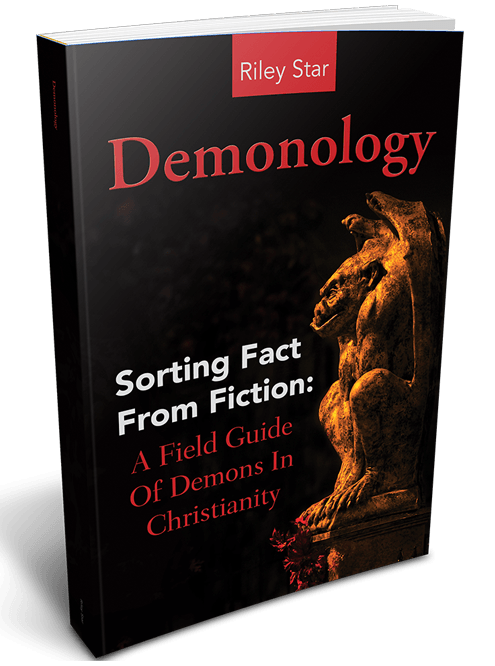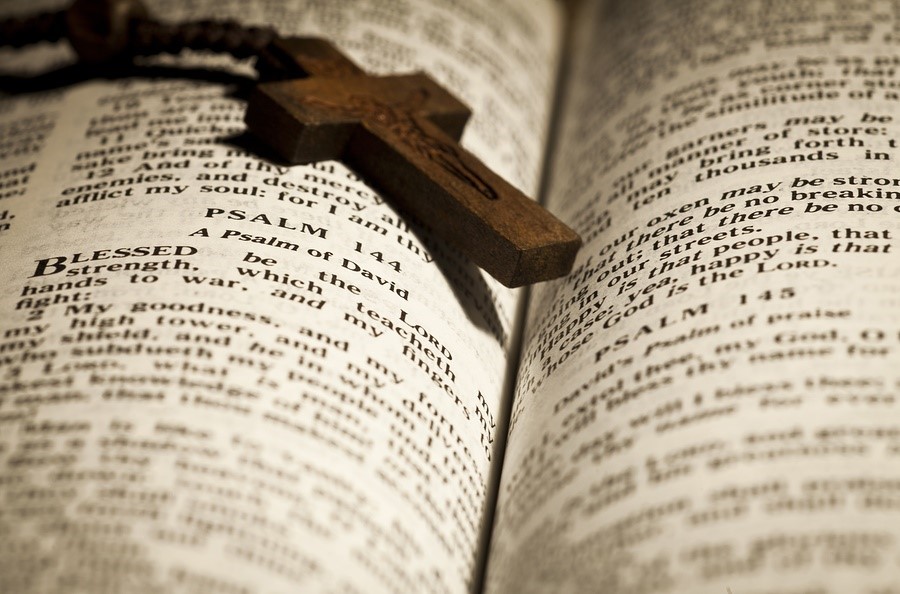CHAPTERS
Navigate to chapter
► Chapter 1: A Theological Look at Demonology
► Chapter 2: Considering Demonic Possession
► Chapter 3: Demons A – Z
► Chapter 4: Concluding Remarks
Chapter 1: A Theological Look at Demonology
What exactly is demonology? Like any word that ends in “ology,” it’s tempting to simply say, “Demonology is the study of demons,” and be done with it. Unfortunately, understanding demonology as an aspect of theology is not that simple.
It is perhaps more accurate to say that demonology is the study of supernatural beings that are not gods. This can include spirits that might also be considered benevolent. The discipline varies widely by cultural and spiritual belief.
If, for instance, you believe in demons that are the minions of Satan, but have a strong attraction to a nature religion like Wicca, you might also believe in fairies, elves, sprites or other “spirits” that are considered “mischievous,” but not necessarily “evil” per se. This book will look at demonology in a Western Christian context. It is not, however, a religious book in and of itself.
In the 21st century, more people have a passing conversance with demonology than you might expect, but much of that “knowledge” is derived from popular culture. While entertaining, and often frightening, this type of demonology generally has little to do with the theological study of demons.
Television programs like Buffy the Vampire Slayer, Supernatural, Sleepy Hollow, Being Human, Witches of East End, and Constantine have given an entire generation a paranormal and demonic vocabulary.
Reality programs such as Ghosthunters often feature “demon hunters” like John Zaffis and Ed and Lorraine Warren who claim to overlay “fact” on fiction. Zaffis scored his own show, Haunted Collector, and the Warrens first came to fame due to their involvement in the Amityville Horror case. But how does this blending of entertainment and theology serve the popular perception of demonology? Often, poorly.
One of the most beloved characters in the Buffy series was a green-skinned “Deathwok Clan” demon with red horns named Lorne. He had more in common with a Frank Sinatra-esque lounge singer than a bloodthirsty creature from another realm — and zero credibility in terms of established demon lore. Lorne is a charming fictional creation, but he has no basis in fact. On the other hand, Moloch, the demonic bad guy that plagued “witnesses” Ichabod Crane and Abigail Mills in the first season of the Fox series Sleepy Hollow does have proper demonic bona fides.
Moloch is spoken of in the Bible, as well as in Milton’s Paradise Lost. Long associated with child sacrifice, the series writers made Moloch’s chief agent the disaffected and scarred son of Crane and his witch wife, Katrina. While granted a “mashup” of Washington Irving’s original Legend of Sleepy Hollow and esoteric religious literature, the result is much more commendable than most such attempts.
In 2014, NBC made a demonic entry in their Friday night line-up with Constantine, an adaptation centering on a character from the DC Comic Hellblazer. In the series, rogue exorcist and demon hunter John Constantine protects the innocent and battles the forces of darkness in uneasy alliance with an angel named Manny. Keanu Reeves played the same demon hunter in a 2005 film adaptation also called Constantine.
In a review of that work published in the Journal of Religion and Film, Jeffry Mallinson, dean of the School of Theology at Colorado Christian University wrote:
Audience members with any theological or biblical background will have difficulty willfully suspending disbelief. Much of the plot depends on a caricature of Roman Catholic theology where one is damned on a technicality or redeemed through a loophole. All of this occurs without the satire of Dogma (1999)*. Particularly distracting are moments when John’s Apocalypse is called “Revelations,” and when an esoteric prophecy is found in a lost chapter of 1 Corinthians. The imagined text would have been more plausible as a Gnostic manuscript or secret copy of “Revelations.” This may seem hypercritical; yet such distractions hinder the creation of a plausible fantasy world.
* Dogma, with Ben Affleck and Matt Damon, is summarized on IMDB.com in this way: “An abortion clinic worker with a special heritage is called upon to save the existence of humanity from being negated by two renegade angels trying to exploit a loop-hole and reenter Heaven.”
While it might, indeed, seem hypercritical to take exception with the Book of Revelation being referred to incorrectly in the plural, the greater point is the ease with which scripture and esoteric texts can be used as plot devices with no fear of a discerning general public quibbling. The average “man on the street” would be hard pressed to pronounce much less correctly identify the origin of a Gnostic manuscript.
____________
Note:
Gnosticism was a 2nd century heretical movement in Christianity that taught a belief in the demiurge, a lesser divine being who ruled the earth, while Christ was seen as the emissary of a more remote and supreme being. In this school of thought, salvation or redemption depended on the attainment of esoteric knowledge or “gnosis.”)
These same “men on the street,” who would draw a blank on Gnosticism could undoubtedly identify “666” as the mark of the anti-Christ, offer up at least one paranormal story about a haunting, and likely assert the presence of Satanic worshippers among us. Never mind the fact that Satanists in the tradition of Anton LaVey, do not worship the Christian devil nor are they interested in being the evil counterparts of Christian churches.
LaVey’s followers are, however, atheistic and materialistic. For them, Satan and demons are psychological symbols and representations of humankind’s vital nature. Unlike teenagers spray-painting inverted crosses and burning black candles, Satanists rarely perform rituals. They do approach life from a skeptical perception and embrace unbridled devotion to sensual enjoyments of all kinds from fine food to sexual pleasure.
You can feel free to mix anything else you like into this “common knowledge” conception of Satan, demons, and evil. Throw in a little black metal music and Harry Potter for good measure. Few of the associations really hold together in a factual interpretation, but they do fit neatly into a fundamentalist religious filter that posits a cosmic battle between the ultimate good, God, and the ultimate evil, Satan. This view has, however, evolved over many centuries of debate about what actually constitutes good and evil.
Before we go on, I want to say that I am content for the reader to determine according to their own belief structure, the role of evil in this world. You may see demons as a metaphor for the internal struggles with which we all cope and that have figured heavily in Western thought and literature. You may see demons as active agents of Satan on earth.
For the purposes of this text, demons will be presented, theologically, as creatures in the service of Satan. In this view, their role is to subvert man’s relationship with God by trickery and potentially possession.
The overriding point of this text, however, is to separate “fact” from “fiction” and de-sensationalize the popular, “common knowledge” view of demons that does nothing but fan the flames of religious and spiritual fears.
Many impressive books have been written about the evolving role of Satan in theological interpretation. I especially commend to you The Origin of Satan: How Christians Demonized Jews, Pagans, and Heretics by Elaine Pagels.
While acknowledging that I may be going down something of a slippery slope, I want to offer at least a conceptual summary of the evolving role of Satan as it has come down to us in Western religious thought. Since all demons serve him, he is the ultimate bad guy in this story.
Anyone even mildly conversant with the Biblical account of the life of Christ knows that he went into the desert before he began his public ministry. This is recorded in both the Gospels of Matthew and Luke. Jesus spent forty days and forty nights in the desert struggling with Satan.
To fully understand how Christian theology developed to accommodate the twin concepts of good and evil as polar opposite locked in a cosmic struggle, we must mythologically step back from the question for a moment.
Creating a figure like Satan that is the embodiment of evil is an attempt to explain forces of chaos and confusion over which people exercise very little practical power.
It is a mistake to assume that the word “mythology” means something that is not true. A myth is an instructive story. Taken in this literal definition, scripture is myth.
That does not mean that it is not true as it is held close in the hearts of the faithful. Other cultures however, have their own mythology, and those stories offer interesting corollaries to standard Western Christian belief.
In Egyptian mythology, for instance, we find an incredibly all-purpose “devil” in the figure of the god Seth. He was believed to be responsible for an impressive array of chaos and confusion. He was the ruler of the desert and of foreign lands, of storms and turbulent seas.
His powers were associated with natural catastrophes including earthquakes. He was seen as the opposite of all of the life-affirming qualities of his brother Osiris. Instead, Seth signified darkness and disorder.
Seth murdered his brother Osiris, cut up his body, and scattered the pieces throughout Egypt so Osiris could not gain immortality in the afterlife. The wife of Osiris, Isis, gathered up the scattered pieces and reunited them, helping Osiris to secure eternal life and to become the king of the underworld.
Horus, the son of Osiris, exiled Seth to the desert for eternity for his crime. Clearly, there are similarities to this story and to that of Cain and Abel in the Christian Bible.
I do not share this Egyptian myth to suggest to Christians that the account of events in their holy book is incorrect. Instead, this is an illustration of a different society attempting to come to terms with the duality of good and evil. This is a theme as old as man himself, and one that continues to capture our imagination and places us on the horns of societal and personal moral dilemmas.
To grasp the evolution of Satan as Christians know him today, it is also important to realize that the Hebrew Bible is much less monotheistic than the Christian New Testament.
Before the appearance of Satan in the Hebrew Bible, the text introduces readers to angels. These are celestial beings referred to in Hebrew as the mal’akim or messengers. For instance, it was a mal’ak that guided Moses to the Promised Land.
These messengers might deliver the word of God to a prophet, assign a special task to a chosen person, announce a significant birth, guide an individual toward the correct path, offer comfort, or administer punishment.
Not all of these messengers, however, behaved appropriately, or we would not have the story of the sons of God who seduced human women leading to the birth of the race of giants called the Nephilim.
Basically, the Hebrews made accommodations for good and bad angels. The fully formed idea of demons only develops later in the tradition of the Christian faith. This is not to say however that there are not mentions of demons in the Hebrew Bible*, although the references are problematic in light of the belief that Christians hold today.
Note:
The term “Hebrew Bible” refers to the collection of Jewish texts that are used as the canonical sources for the Christian Old Testament. Most are in Biblical Hebrew with some Biblical Aramaic. The content is not the source for the canonical portions of the Roman Catholic Old Testament. “Hebrew Bible” is meant to be a scholarly neutral term with no implication of interpretative tradition.
As a comparison, the 46 books of the Catholic Old Testament are:
Genesis, Exodus, Leviticus, Numbers, Deuteronomy, Joshua, Judges, Ruth, 1 Samuel, 2 Samuel, 1 Kings, 2 Kings, 1 Chronicles, 2 Chronicles, Ezra, Nehemiah, Tobit, Judith, Esther, 1 Maccabees, 2 Maccabees, Job, Psalms, Proverbs, Ecclesiastes, Song of Songs, Wisdom, Sirach, Isaiah, Jeremiah, Lamentations, Baruch, Ezekiel, Daniel, Hosea, Joel, Amos, Obadiah, Jonah, Micah, Nahum, Habakkuk, Zephaniah, Haggai, Zechariah, Malachi
In the Christian Old Testament, the 39 books are:
Genesis, Exodus, Leviticus, Numbers, Deuteronomy, Joshua, Judges, Ruth, 1 Samuel, 2 Samuel, 1 Kings, 2 Kings, 1 Chronicles, 2 Chronicles, Ezra, Nehemiah, Esther, Job, Psalms, Proverbs, Ecclesiastes, Song of Solomon, Isaiah, Jeremiah, Lamentations, Ezekiel, Daniel, Hosea, Joel, Amos, Obadiah, Jonah, Micah, Nahum, Habakkuk,, Zephaniah, Haggai, Zechariah, Malachi
Where the names of other ancient texts are used in this book, I will try to identify them individually.
____________
In Leviticus, there are references to a demon named Azazel. It would appear in the text that Aaron sacrifices a goat to Yahweh and another to the demon. The King James version of the Bible gets around this by saying that Azazel is a place name, but it is quite clear in Jewish literature that Azazel is the name of a demon.
He is credited with teaching humans to make knives, swords, and shields. In the Book of Enoch, an ancient Jewish text but not a canonical book of the Bible, Azazel reveals the internal secrets of heaven and teaches man all forms of oppression upon the earth. Azazel also becomes transformed into the serpent that tempts Adam and Eve in the garden.
Another demon from ancient Jewish literature is Lilith who in later tradition is regarded as the first wife of Adam. She is found in the company of unclean animals and is in league with the head of the fallen angels, her husband Sammael.
Lilith actively works for the expulsion of Adam and Eve from the garden and in some traditions she is the servant responsible for the temptation story in Genesis. Following the expulsion, Lilith continues her attacks on mankind, and is generally held to be responsible when small children die.
The Hebrew text, particularly in the book of Isaiah, makes it clear that God is responsible for both good and evil. Satan, on the other hand, is a part of God’s council. He is the Accuser, who serves at God’s request.
The best illustration of this role occurs in the Book of Job. Basically, God throws Job under the bus to test him. When seen in this light, the story is the tale of God and Satan working together to put Job and his faith under the microscope.
It is not the purpose of this text to fully explore Hebrew theology. If it were, it would become increasingly clear that Satan is an ambiguous figure as is his role on God’s council. It would seem that Satan is an obedient servant of God, sending evil and misfortune to the unfaithful and the faithful.
There is none of the familiar imagery of modern Christianity that shows Satan as the supreme ruler of hell, sitting at the head of an army of demons for the purpose of waging war against God and humanity.
Grasping the familiar personification of Satan, requires looking to the period between the time when the last of the Hebrew Scriptures were composed, and the beginning of the life of Christ. This is generally taken as being 300 years in duration. During this time Satan, as we know him, came into his own.
These 300 years are referred to as the Babylonian Captivity. They begin with the fall of Jerusalem in 586 BC to the Babylonians followed by the exile of the Hebrews throughout the region. During this exile, the Hebrew people came into contact with Persian and Zoroastrian religious practices.
The evolution of Jewish literary expression subsequently transformed angels from “messengers” into distinct celestial beings with personalities and given names. Religious writers began to imagine a heavenly world which was much more elaborate.
The absolute dichotomy of good versus evil began to take shape. The word demon assumed a growing negative connotation for the Jews. These creatures were seen as being in league with an arch enemy who stood in opposition to the true God. Their role was to entice humans to stray from their faith. Demons excelled at tempting mankind and at promulgating false doctrines.
Thus, both the Jewish and then the Christian faith developed a working concept of a spiritual war. The conflict was, however, expected to come to a resolution on the Day of Judgment when evil fell before the power of ultimate good. Until that happens, specific demons are free to wreak havoc through spreading misfortune, cultivating sin, and exploiting the flaws of mankind.
What are Demons According to the Bible?
The Biblical interpretation is that demons are the fallen angels exiled from heaven with Satan as described in Revelation 12:9:
“And the great dragon was cast out, that old serpent, called the Devil, and Satan, which deceiveth the whole world: he was cast out into the earth, and his angels were cast out with him.” (KJV)
About one third of the angels are believed to have gone with Satan. In Job 28:4-7, we learn that angels were created before the earth and that Satan fell from grace before God tempted Adam and Eve in the Garden of Eden as described in Genesis 3:1-14.
Satan’s fall is also described in Isaiah 14:12–15, which is one of the more poetic renditions of the story:
Want to read the entire thing?





